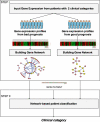Prognostic transcriptional association networks: a new supervised approach based on regression trees
- PMID: 21098433
- PMCID: PMC3018815
- DOI: 10.1093/bioinformatics/btq645
Prognostic transcriptional association networks: a new supervised approach based on regression trees
Abstract
Motivation: The application of information encoded in molecular networks for prognostic purposes is a crucial objective of systems biomedicine. This approach has not been widely investigated in the cardiovascular research area. Within this area, the prediction of clinical outcomes after suffering a heart attack would represent a significant step forward. We developed a new quantitative prediction-based method for this prognostic problem based on the discovery of clinically relevant transcriptional association networks. This method integrates regression trees and clinical class-specific networks, and can be applied to other clinical domains.
Results: Before analyzing our cardiovascular disease dataset, we tested the usefulness of our approach on a benchmark dataset with control and disease patients. We also compared it to several algorithms to infer transcriptional association networks and classification models. Comparative results provided evidence of the prediction power of our approach. Next, we discovered new models for predicting good and bad outcomes after myocardial infarction. Using blood-derived gene expression data, our models reported areas under the receiver operating characteristic curve above 0.70. Our model could also outperform different techniques based on co-expressed gene modules. We also predicted processes that may represent novel therapeutic targets for heart disease, such as the synthesis of leucine and isoleucine.
Availability: The SATuRNo software is freely available at http://www.lsi.us.es/isanepo/toolsSaturno/.
Figures


References
-
- Azuaje F, et al. Computational biology for cardiovascular biomarker discovery. Brief. Bioinformatics. 2009;10:367–377. - PubMed
-
- Becker KG, et al. The genetic association database. Nat. Genet. 2004;36:431–432. - PubMed
-
- Breiman L. Random forests. Mach. Learn. 2001;45:5–32.
-
- Chu F, Wang L. Applications of support vector machines to cancer classification with microarray data. Int. J. Neural Syst. 2005;15:475–484. - PubMed
Publication types
MeSH terms
LinkOut - more resources
Full Text Sources
Other Literature Sources
Medical
Molecular Biology Databases
Research Materials

